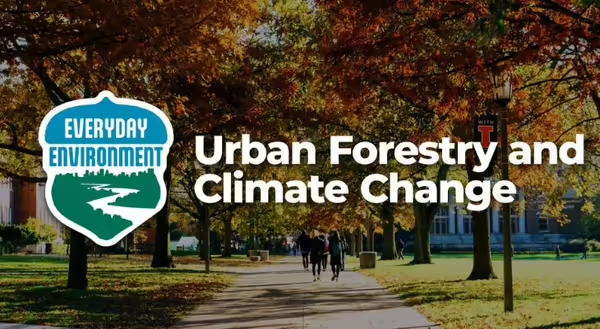
I’m walking through a central Illinois neighborhood in mid-May this spring. The temperature is 92 degrees Fahrenheit, one degree shy of the record, and most people still haven’t acclimatized to the heat. In broad daylight, the temperature is unbearable as the heat radiates off the pavement. I duck under the shade of a large tulip poplar for some respite; the temperature is about 10 degrees cooler. Below the canopy, the spring ephemerals are tapering off, giving way to the adjacent flowering elderberry. In the background, bees drone between blooms, and a recently fledged barred owl calls for its parent.
These urban trees and the ecosystem they create, which we collectively call the urban forest, provide essential services for both the humans and wildlife that live within it.
What is the urban forest?
Like in any forest, trees are the most important component of the urban forest, but other plants and green infrastructure also play an important role and contribute to maximizing the benefits an urban forest can provide. So, whether you are walking in a city park, relaxing in your backyard, or driving past a landscaped boulevard, you are somehow interacting with the urban forest.
Why is the urban forest important?
Climate change is increasing the risk of excessive heat-related deaths, especially among urban residents. In the US, about 80% of people live in urban areas and experience elevated temperatures due to the heat island effect. Urban forests are one of the few areas that can both mitigate and adapt to climate change. When managed effectively, urban forests can serve as carbon sinks, removing carbon and other greenhouse gases from the atmosphere, mitigating the effects of climate change. Perhaps even more importantly, when urban forests are strategically planned, they can assist in climate adaptation by reducing temperatures in heat islands, removing pollution from the air, and reducing water runoff during storms.
What can we do to help?
One of the best things you can do to support the urban forest is to plant a tree. Planting a tree on the property where you live gives you the most freedom to select the type of tree you’d like and its location. But be careful, because you need to plant the right tree in the right place to maximize the benefits to the urban forest! For example, you would not want to plant a water-loving tree like a river birch in a very dry area, and if you want to support wildlife in addition to the other benefits, you might consider planting an oak tree. If you do not have space where you live, many cities have cost-sharing programs that allow people to select trees to be planted in a vacant street tree location.
If you aren’t able to plant a tree yourself, there are many volunteering opportunities with local park districts, non-profit organizations, and Illinois extension offices via the Illinois Master Naturalist Program. As you are learning about urban forestry you may also notice tree damage or health problems; many cities and organizations have platforms that allow citizens to report this type of information. For example, if you notice herbicide drift damage, you can report it here, and in the city of Chicago, you can use the 311 platform to report tree damage.
Next time you are taking a walk through your neighborhood, take note of the urban forest around you and think about how it is benefiting your community but also how it might be improved. One of the most exciting aspects of urban forestry is that anyone can participate, whether you are a certified arborist, a private landowner, or a community member there is some way you can enjoy and support the urban forest!
Thank you for reading!
Everyday Environment is a series of blogs, podcasts, webinars and videos on exploring the intricate web of connections that tie us to the natural world. Check out the podcast episode on this topic to hear more about the Urban Forest with Justin Vozzo
Subscribe to Everyday Environment Newsletter More about Everyday Environment